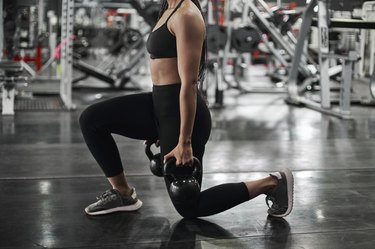
Squats are the Beyonce of the exercise world — multi-talented and definitely deserving of all the praise they get. And if squats are Beyonce, lunges are Ciara — equally talented but arguably underrated.
Celeb musicians aside, lunges are a functional lower-body exercise that just might sculpt your legs even better than squats. As a single-leg exercise, lunges offer an array of benefits from better balance to leaner legs to a stronger core. So, before you devote your entire leg workout to squats, consider these need-to-know lunge advantages.
Video of the Day
The Problem With Too Many Squats
The squat is probably one of the most highly praised exercises — and with good reason. Squats support your daily movements (think about how many times you squat down to pick something up) and can help strengthen your tendons, bones and ligaments, according to the American Council on Exercise (ACE).
But as with all exercises, that doesn't mean you should go overboard with your squats. If you do, or if you compete in quad-dominant sports like running or cycling, this can lead to over-development of the muscles at the front of your thighs, according to Carolina Araujo, certified personal trainer.
Doing them incorrectly can have the same result. If you stop your squats when your knees are bent to an angle greater than a 90 degrees, initiate the movement at the knees or you lift your heels off the floor, your quads will take the brunt of the work, Araujo says.
Having strong quads definitely isn't a bad thing, but too much strength can lead to a muscle imbalance if you don't also give your glutes and hamstrings some attention, Araujo says. As a result, you can become more prone to lower back, hip or knee pain.
Plus, if you're doing squats with your knees at greater than a 90-degree angle or if you're lifting a weight that's too heavy, this exercise can cause excessive stress on your lower back and can eventually lead to injury, according to the American College of Sports Medicine (ACSM).
Why You Should Incorporate More Lunges
Lunges are a straightforward, functional exercise, and they have a handful of benefits you won't get from traditional squats.
First off, forward lunges have been shown to target the glutes (specifically the gluteus maximus and medius) and hamstrings more effectively than body-weight squats, according to the ACE. This helps balance out the muscles along front and back of your legs, preventing muscle imbalance as discussed above.
Lunges are also functional in a different way than many other lower-body exercises, as they involve forward movement, per the ACE. Mimicking our usual walking pattern, walking lunges can help encourage proper gait and posture.
And unlike squats, lunges are a unilateral exercise, which is a great way to address muscle imbalances across the left and right side of your body, Araujo says. While imbalances won't directly cause injury, they can lead to improper form while you exercise, which can be problematic. In some cases, muscular imbalance can lead to improper posture, too.
Also known as single-leg exercises, these types of moves help isolate one side of the body without letting your more dominant half take over. Over time, they'll help correct any pre-existing imbalance you may, preventing future asymmetries, too.
Lunges are also a great balance-building exercise, Araujo says. Standing on one as you shift your weight back and forth will trigger the small stabilizer muscles in your body that are critical for your overall balance and coordination.
Try These 2 Lunges for Stronger Legs
Now that you're aware of all the leg sculpting benefits of lunges, swap out some of your squats reps with one of these lunge variations during your next leg-day workout.
Move 1: Dumbbell Lunge
- Start standing, holding a dumbbell in each hand. The weights can hang at your sides or you can lift them up to your shoulders.
- Step a few feet forward with your left foot.
- Lower into a lunge until both knees are bent to 90 degrees. Your back knee should hover just above the ground, and your front knee should be stacked over your ankle.
- Hold for a beat before pushing through your front foot to return to standing.
- Repeat on the other leg.
Tip
Considering front lunges propel your body forward, they can be a bit taxing on sensitive knees, as they're forced to bear the full weight of your body, according to the ACE. If you do struggle with sensitive or painful knees, reverse lunges are a safer alternative that will still give you the unilateral benefits.
Move 2: Dumbbell Reverse Lunge
- Start standing, holding a dumbbell in each hand. The weights can hang at your sides or you can lift them up to your shoulders.
- Step your left foot back a few feet, keeping the right foot planted.
- Lower into a lunge until both knees are bent to 90 degrees. Your left knee should hover just above the ground, and your right knee should be stacked over your ankle.
- Hold for a beat before pushing through your right foot to return to standing.
- Repeat on the other side.